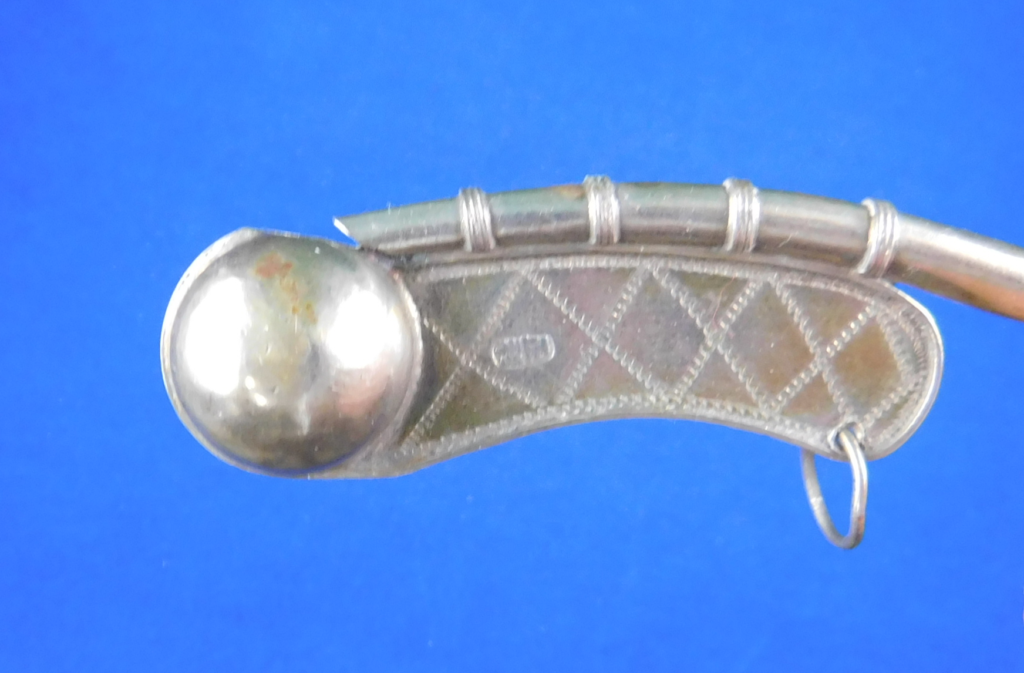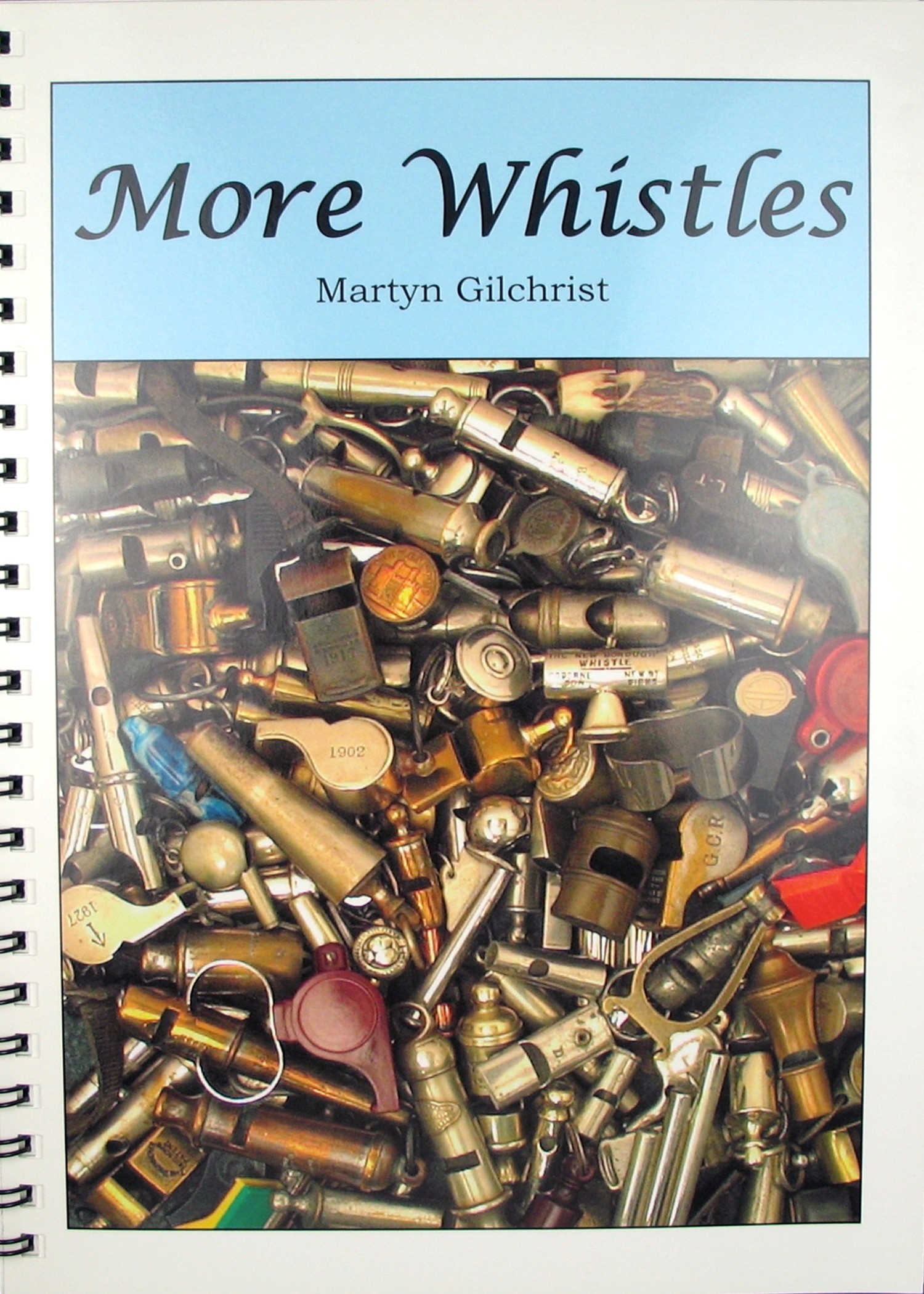WHISTORY
An engaging sub area of whistle studies is wriggle work. It is found specifically on boatswain whistle keels and on very rare occasions, other whistles. Simple, ornate, professional, ‘rough’, this technique has been used by very few countries, notably The UK, China and France.
The metals most used for designing wriggle work were pewter, copper, brass, aluminum and silver… our study is with the use of silver, nickel silver and plated brass on Boson whistles. Why Bosons ? How was it used ?
Wriggle work was/is an engraving technique on metal that surfaced in the UK circa 1600 and was first used as decoration on pewter ware. It saw its day from about 1689 to 1740, thereafter only being seen occasionally, predominantly on silver or brass.
Later perhaps due to English influence this technique would migrate to China and then France. History is scant about how pervasive wriggle work became. Eventually in the USA it would come to be used on brass musical instruments as trim work and elaborate ‘filler’ work over large surfaces of drums, saxophones, and other musical instruments by noted engravers.
In its beginning it came to be called wriggle work because the side to side ‘push’ of the graver tool caused a zipper like design that could travel around perimeters of different objects and crisscross into open fields. As time passed skilled engravers would create patterns of leaves, flowers and other more elaborate decorations.

One source reports about aluminum decorations from post war fields – ‘One can find many decorated items made by soldiers of different countries from both World War One and World War Two. It appears to mostly be the wriggle work style of engraving. Both zigzag style and the zipper style of wriggle work.’
Early on, silver dominated boson whistle construction, even when other whistles were being manufactured of brass, nickel silver and nickel-plated brass. Why would that be ?
Another source states: ‘Even early civilizations knew the value of silver as a way to make utensils. But what they might not have realized is that silver is such a relatively safe metal that it actually has anti-septic properties. Bottom line: silver kills germs, bacteria, and fungi – and even better, and avoids killing us because its toxicity is not at the level of other heavy metal’
As early as the 18th century boson ( boatswain, bosun ) whistles began to appear with wriggle work in the UK. The flat surface of the ‘keel’ was perfect for such a technique. It is a flat working surface and thin and at the same time plain and open. Silver was used for its antiseptic use and beauty and here was found both a practical and artistic use with wriggle designs. The questions might be asked, was wriggle work used also for the purposes of practical personalization too ? Could it have been used to help identify each particular shipmate ? It only makes sense to have been so.
Suffice it to say, there is a tremendous amount of variety within bosons pipes themselves and what emerges at the same time is also wide and perhaps unique wriggle work patterns found on these type whistles. Coupled with the ornate boson whistle, the wriggle work could be elevated to a beautiful art form.
Rather than try to present every whistle known, we will concentrate on this aspect of wriggle work on decorating the keels. One point of observation is identification. Whereas English silversmiths made every effort to stamp with their hallmarks, ( From the end of the 12th century the craft of silversmith has been regulated in conformity with Royal Ordinances and acts of Parliament )

On the other hand China did not. This could be confusing when seeing silver hallmarks on Chinese import silver. These were more of a maker’s mark and an effort at matching the contemporary silver of the day. So, one will find a faux ‘hallmark’ or English letters and perhaps next to it in Chinese characters a maker’s mark.


Note some Chinese makers/distributers marks:

(Special Thanks to Don Jian Guo, Photo)

“The Zheng Li silver mark is very rare; it is only recorded on silver bosun’s pipes.” – Page 976 of Adrien Von Fersh, Chinese Export Silver 1785-1940

England and the Americas had a tremendous influence in the ports of Shanghai, Canton and Hong Kong during this time period late in the 1800’s where there was much trading by sea. However what sailing vessels were employed by the Chinese beyond junks and riverboats ? Did they sail the seas as did the English and the Americans ? So a further question begs to be asked — were the Chinese bosons made for the Chinese themselves or for foreign sailors visiting the ports of trade ?
France would eventually employ wriggle work on its own bosons. They appear to be later vintage. The materials changed by this time to more durable forms. Was the wriggle work in France influenced by the UK and China ? Its primary use in France seems to be utilitarian identification more that ornamentation.
England has a long history of silversmiths and a nautical background. Their boson whistles reflect that with wriggle work approaching fine art. Chinese and French examples never approached this level. So, the conclusion would be that UK silver smiths used wriggle work for both identification/personalization and artwork/ornamentation, while France and China’s use was primarily identification/personalization and for China, retail sales to foreigners.
WHISTOLOGY
We will focus on three geographical/time areas:
- The UK – circa 1800 to 1930
- France – circa 1900 to 1930
- China – circa 1890 to 1930
First, let’s examine a group picture of some UK silver smiths. When doing so, note the elaborate designs. Their wriggle work was on a higher plane. The silversmiths typically used the longer English style ‘keels’ to create beautiful scenes of very high quality. The ‘guns’ are more typical of English bosons.
The round bowl called the buoy vary, and many times accompanied by a nautical symbol prevailing on the sides.

Chinese buoys vary tremendously and set off a common theme of keels and inherent wriggle work yet appear more rustic or even plain.


Somewhere along this timeline the French manufacturers picked up the use of wriggle work, but rarely with silver, mostly nickel-plated brass. Their use was a more functional identifier rather than ornate.


What types of wriggle work were employed ?
- Criss cross
- Trimming
- Field fill
- Flowers
- Leaves
- Nautical symbols
- Cartouche
Note an uncredited example from the internet that did use wriggle work, although rare to see outside of boson whistles.

We will add to the article as models appear.
Bibliography:
Engraving forum.com for engravers, jewelers & metal artists
“Wriggled Decoration on Pewter” by Ronald F. Michaels
Wikipedia Engraving
You tube demo https://www.youtube.com/watch?v=BHclazrDzNQ
Engravers café https://engraverscafe.com/threads/rudimentary-wriggle-work-soldiers-art.2571/
Dictionary.com
Guide to Hallmarks – Antiques Trade Gazette
Sell Gold HQ — http://www.sellgoldhq.com/why-silver-makes-the-best-silverware/
TWG
Posted July 5, 2020









